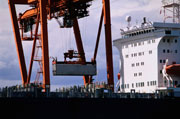The $787 billion stimulus plan that U.S. President Barack Obama signed on February 17 contained a provision that was hardly unexpected but nevertheless worrisome to proponents of global free trade. It was a requirement that projects funded by the bill buy American-made goods whenever possible. When governments around the world spend vast sums to stimulate their economies, it seems only reasonable for each to invest at home. After all — or so the argument goes — why should American taxpayers pay for steel from Canada when U.S. steelmakers are struggling?
Economists and political leaders in the U.S., Europe and elsewhere worry that this simple logic is spurring protectionist sentiment around the world, threatening free-trade principles that are crucial to any global economic recovery. This comes on top of concerns about the decline in trade from shrinking consumer demand and credit problems caused by the financial crisis.
For the moment, protectionism is less a reality than a threat — but it is a growing threat to be taken seriously. “Actually, I’ve been very pleased that there has so far been less protectionist sentiment than one might have expected,” says Wharton finance professor Jeremy J. Siegel. “Everyone has the Great Depression in mind — the big tariffs.”
The World Trade Organization is so concerned about what it sees as a rising tide of protectionist impulses that in a February 3 speech, Director-General Pascal Lamy invoked the infamous 1930 Smoot-Hawley Act, which boosted tariffs on more than 20,000 products imported to the U.S. The act sparked a trade war that aggravated the Depression, according to many economists. “Whether it is with tariffs or with new, more sophisticated faces of Smoot and Hawley, today we run the risk of sliding down a slippery slope of tit-for-tat measures,” Lamy warned.
In the U.S., Democrats in the House wrote strong “Buy American” provisions into their economic stimulus bill, though the terms were eased in the Senate at the urging of the Obama administration. The final bill requires use of U.S. iron, steel and manufactured goods in projects funded by the stimulus plan. Exceptions are allowed in the “public interest,” or if using U.S materials would increase project costs by 25% or more.
Most importantly, the final bill, unlike the House version, requires that the U.S. continue to abide by its international trade agreements. That calmed many free-trade groups, such as the U.S. Chamber of Commerce, which had lobbied hard against the House measure.
But the issue is not dead. While Canada, Mexico and many European countries have trade agreements with the U.S., trade experts note that China, India and many other developing nations are not as well protected. These countries could thus be shut out of some bidding on stimulus-funded projects, giving them an incentive to retaliate.
Also, many experts think additional stimulus will be required and worry that protectionist sentiment will grow, even though the Obama administration has taken strong free-trade positions. Meanwhile, there have been protectionist stirrings around the world. France and Italy, like the U.S., have instituted measures to aid car makers. Some British job-protection measures are seen as potentially protectionist, and a number of countries have criticized China for keeping its currency artificially weak to bolster exports.
Russia recently raised tariffs or provided subsidies for dozens of goods. Egypt imposed duties on sugar and the U.S. has put new tariffs on some Chinese goods, including mattresses. The European Union has imposed tariffs on Chinese screws and bolts. India has imposed restrictions on the import of Chinese steel and textiles.
On February 14, members of the G7 — the U.S., Japan, Germany, Britain, France, Italy and Canada — concluded an emergency meeting in Rome with a statement pledging not to undermine free trade while dealing with the recession. At the start of the two-day meeting, Britain and France issued statements warning that the world should not repeat the Depression-era trade wars. Clearly, worry about protectionism is widespread.
If the world is to recover from the recession, it must avoid trade wars, especially given the growing interdependence of nations’ economic interests, says Wharton management professor Stephen J. Kobrin. “It’s critical. It’s pretty clear that protectionism exacerbated the Depression last time, and [economies] are more integrated now.”
What Is Free Trade?
Free-trade principles are simple: Every country makes what it makes best, spurring competition and keeping prices as low as possible for everyone. The country with lots of iron ore but little farmland makes steel, while the one with little ore and lots of farmland grows wheat. Together, they produce more iron and wheat than if each tried to produce both, and they do it more efficiently.
But support for this textbook principle breaks down in the real world. Mercantilism, which encouraged a nation to export more than it imported, was the dominant economic policy among European countries in the 16th through 18th centuries, and in some nations well into the 19th century. Generally, the historical trend since then has been to more free trade, and markets are more open today than at any time in modern history.
“It leads to long-run efficiency,” says Wharton finance professor Franklin Allen. “You have people specializing in the things they do best. Otherwise, you end up with people in some countries who don’t have the right skills or resources doing inefficient things.” But anti-free-trade pressures are always present or lurking under the surface, and they are easily rationalized. “If you’re the only country that has a buy-domestic policy, you might gain [from protectionism],” Siegel says. “But if others retaliate by having buy-domestic policies, then everyone loses.”
Today, workers, their employers and unions — and politicians who represent them — often make free trade the villain when jobs are lost to cheap foreign competitors. The North American Free Trade Agreement, passed under the Democratic Clinton administration, became a political issue in last fall’s U.S. presidential campaign, with union groups charging it had cost American jobs. Free trade can indeed do that, as when U.S. textile workers lost out to foreign competitors. But it can create jobs for others, according to Allen. “I think we have to learn to compete on that basis.”
While free trade may benefit a society in general, few ordinary citizens give it much thought, so public support for free trade is rarely as passionate as opposition from the minority worried about losing jobs. Dennis C. Blair, Obama’s director of national intelligence, recently warned that popular unrest from economic problems threatens to topple some foreign governments. National leaders thus have strong incentives to protect domestic industries.
Even people who believe in free trade as a general principle often argue there are exceptions. Most economists concede, for example, that countries should protect their defense industries rather than depend on foreign suppliers.
Free-trade issues are rarely cut and dried. Wharton finance professor Richard Marston says stimulus programs are a good example. “Buy-America provisions are a tricky issue,” he notes. “Suppose all countries have the same slowdown, but only one country has a stimulus program, financing it with debt. Then the other countries free-ride on the stimulus, because both direct and indirect spending out of the stimulus spills over into imports, at least to a certain extent.” (This can be mitigated by focusing stimulus spending on things that will benefit the U.S. economy, like repairs to roads and bridges, he says.)
Debate over whether trade is really free is constant, with countries routinely accusing each other of tipping the playing field. Producers can be protected with tariffs on imports, or by government subsidies. To the purist, U.S. government aid to General Motors, Chrysler and Ford is unfair to foreign automakers. Even strong free-trade advocates may rationalize such protectionism in a crisis, especially if it can be sold as temporary.
Currency Intervention
Few cases illustrate the complexity of trade issues better than government intervention in currency markets. China’s intervention is designed to keep the yuan low relative to the U.S. dollar, and there was a dust-up between the Chinese and Americans after U.S. Treasury secretary Timothy Geithner recently criticized Chinese policy. From a pure free-trade perspective, currency intervention is improper tinkering, but it is not that simple, Allen says.
“This issue of currency manipulation is an interesting question. I guess I don’t regard it as being such a bad thing. The volatility of exchange rates is so high, it is a problem.” Chinese intervention calms the markets, he notes.
“Chinese intervention in [foreign] exchange markets has the same effect on the relative price of Chinese and American goods as a tariff does,” according to Marston. “And this intervention has been huge. China has accumulated more than $2 trillion in foreign exchange reserves in part because the country has not allowed its currency to appreciate sufficiently.” But this is not the best time to press China to drop this policy, he explains, noting that minor changes have allowed the yuan to appreciate by about 20% since July 2005. “A much larger appreciation would occur if the market were free. But when we are in a worldwide crisis, it’s best not to raise these issues.”
One reason: consumers in the U.S. and elsewhere benefit because intervention makes Chinese goods cheap, though it can hurt other nations’ exporters by making their goods too expensive for Chinese consumers. The U.S. has also benefited because China’s currency moves involve enormous purchases of U.S. Treasury bonds, helping to finance U.S. government debt and keep interest rates low.
Siegel notes that American consumers — especially those pinched by the recession — benefit from the lack of tariffs or other obstacles to free trade with China. “We import more than many other countries, and China is a net exporter.” He adds: “We’ve been able to import a lot of goods, at very low cost, that have generally helped our standard of living and our consumption.”
While plenty of experts worry about any rise in protectionism, some point out that for now other factors are far more damaging to international trade. The World Bank has predicted trade will fall this year for the first time since World War II, and many ports are already reporting double-digit declines. “Up to half the global bulk fleet is idle,” notes Wharton management professor Marshall W. Meyer, referring to ships that carry commodities like iron ore, grain and coal. “Some of the larger shippers have taken delivery of new ships and simply parked them.”
The Baltic Dry Index of shipping prices is down 90% from the high reached in May of 2008, he says. “At the bottom, which was a few weeks ago, you could have leased a Panamax bulk ship — that’s the biggest thing that can go through the Panama Canal — for about $500 a day. In other words: what [you might pay] for a [Cadillac] Escalade.”
Oil shipping is holding up fairly well, Meyer says, but shipping of boxcar-like containers appears to have fallen dramatically. Since container ships run on schedules like airlines, their owners keep them steaming — but with lots less cargo. “Probably 90% of carriers, and there are lots of them, are losing money this year.”
Falling consumer demand for goods has been exacerbated by the lack of credit from the financial crisis, according to Meyer. It has become next to impossible for buyers to get letters of credit to guarantee they will pay for deliveries. “You don’t put your goods on a boat until you have a document insuring you will be paid for them when they land on the other end.”
The bottom line, according to Meyer: The threat of protectionism is just one ingredient in the witch’s brew of challenges that confronts the global economy. “When you say ‘protectionism,’ I say, ‘Wait a minute, a lot of other things are going on here slowing down global trade.'”



